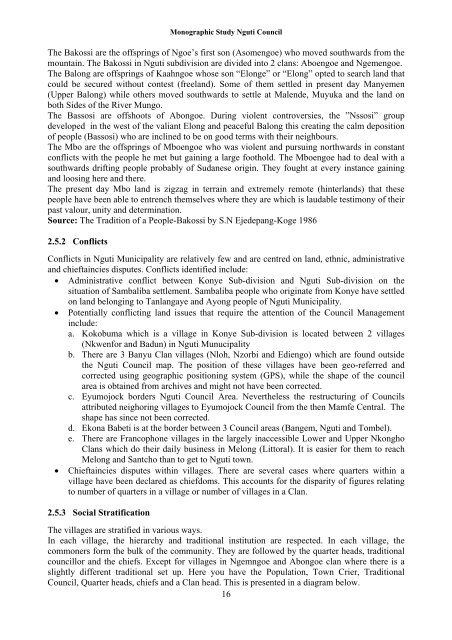nguti council monographic study - Impact monitoring of Forest ...
nguti council monographic study - Impact monitoring of Forest ...
nguti council monographic study - Impact monitoring of Forest ...
- No tags were found...
You also want an ePaper? Increase the reach of your titles
YUMPU automatically turns print PDFs into web optimized ePapers that Google loves.
Monographic Study Nguti CouncilThe Bakossi are the <strong>of</strong>fsprings <strong>of</strong> Ngoe’s first son (Asomengoe) who moved southwards from themountain. The Bakossi in Nguti subdivision are divided into 2 clans: Aboengoe and Ngemengoe.The Balong are <strong>of</strong>fsprings <strong>of</strong> Kaahngoe whose son “Elonge” or “Elong” opted to search land thatcould be secured without contest (freeland). Some <strong>of</strong> them settled in present day Manyemen(Upper Balong) while others moved southwards to settle at Malende, Muyuka and the land onboth Sides <strong>of</strong> the River Mungo.The Bassosi are <strong>of</strong>fshoots <strong>of</strong> Abongoe. During violent controversies, the ”Nssosi” groupdeveloped in the west <strong>of</strong> the valiant Elong and peaceful Balong this creating the calm deposition<strong>of</strong> people (Bassosi) who are inclined to be on good terms with their neighbours.The Mbo are the <strong>of</strong>fsprings <strong>of</strong> Mboengoe who was violent and pursuing northwards in constantconflicts with the people he met but gaining a large foothold. The Mboengoe had to deal with asouthwards drifting people probably <strong>of</strong> Sudanese origin. They fought at every instance gainingand loosing here and there.The present day Mbo land is zigzag in terrain and extremely remote (hinterlands) that thesepeople have been able to entrench themselves where they are which is laudable testimony <strong>of</strong> theirpast valour, unity and determination.Source: The Tradition <strong>of</strong> a People-Bakossi by S.N Ejedepang-Koge 19862.5.2 ConflictsConflicts in Nguti Municipality are relatively few and are centred on land, ethnic, administrativeand chieftaincies disputes. Conflicts identified include: Administrative conflict between Konye Sub-division and Nguti Sub-division on thesituation <strong>of</strong> Sambaliba settlement. Sambaliba people who originate from Konye have settledon land belonging to Tanlangaye and Ayong people <strong>of</strong> Nguti Municipality. Potentially conflicting land issues that require the attention <strong>of</strong> the Council Managementinclude:a. Kokobuma which is a village in Konye Sub-division is located between 2 villages(Nkwenfor and Badun) in Nguti Munucipalityb. There are 3 Banyu Clan villages (Nloh, Nzorbi and Ediengo) which are found outsidethe Nguti Council map. The position <strong>of</strong> these villages have been geo-referred andcorrected using geographic positioning system (GPS), while the shape <strong>of</strong> the <strong>council</strong>area is obtained from archives and might not have been corrected.c. Eyumojock borders Nguti Council Area. Nevertheless the restructuring <strong>of</strong> Councilsattributed neighoring villages to Eyumojock Council from the then Mamfe Central. Theshape has since not been corrected.d. Ekona Babeti is at the border between 3 Council areas (Bangem, Nguti and Tombel).e. There are Francophone villages in the largely inaccessible Lower and Upper NkonghoClans which do their daily business in Melong (Littoral). It is easier for them to reachMelong and Santcho than to get to Nguti town. Chieftaincies disputes within villages. There are several cases where quarters within avillage have been declared as chiefdoms. This accounts for the disparity <strong>of</strong> figures relatingto number <strong>of</strong> quarters in a village or number <strong>of</strong> villages in a Clan.2.5.3 Social StratificationThe villages are stratified in various ways.In each village, the hierarchy and traditional institution are respected. In each village, thecommoners form the bulk <strong>of</strong> the community. They are followed by the quarter heads, traditional<strong>council</strong>lor and the chiefs. Except for villages in Ngemngoe and Abongoe clan where there is aslightly different traditional set up. Here you have the Population, Town Crier, TraditionalCouncil, Quarter heads, chiefs and a Clan head. This is presented in a diagram below.16

















